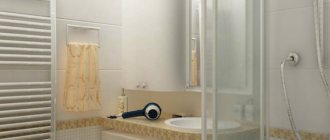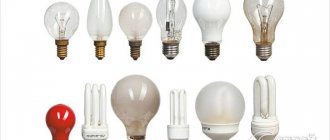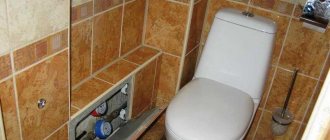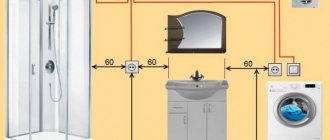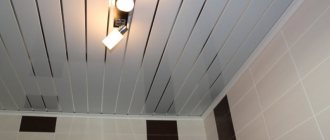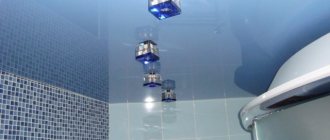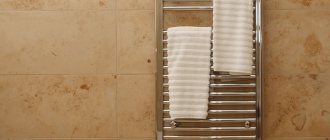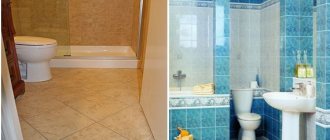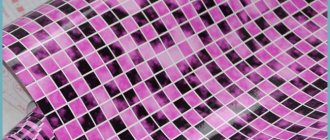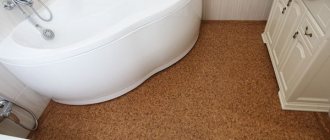The quartblog will explore the issue of lighting in the bathroom, where and how to place lamps correctly, and what types of lamps are suitable.
The problem of bathroom lighting receives undeservedly little attention. While chandeliers, floor lamps and table lamps are being selected for months for living rooms, bedrooms and even kitchens, the bathroom, in a sense, remains terra incognita. Most homeowners believe that the minimum required to illuminate a bathroom is one simple source.
But let's think about whether this is so. In all other rooms, there are supposed to be more light sources, and they are each dispersed in their own area. Thus, all parts of the room are equally illuminated, and you can use all the possibilities at once or separately.
No one will argue that the desk and chair in which we are used to reading in the evenings need additional lighting - a chandelier, naturally, cannot cover all areas. And it’s even more surprising that for some reason different standards apply to the bathroom.
Light calculation
The easiest way to solve the indicated problem is to open the SNiP and find out the reference value. According to the standards, one light source is needed to illuminate an area of 5 m². Since in most cases the bathroom area is rarely large, it is enough to hang one ceiling chandelier. She will be able to make the room bright.
But any changes in the layout and the use of complex systems for decorating ceilings may require adjustments to the distribution of light flow. In this case, experienced designers always have their own best practices. They advise organizing bright but evenly diffused lighting in the bathroom. It will help emphasize the shine and cleanliness of the interior.
Each zone requires lighting Source mebel-go.ru
More recently, when drawing up projects, calculations of the luminous flux were made taking into account the use of conventional incandescent lamps. Today it is not economical to use them, so the existing standards have been revised. The starting point is not the power of the device (W), but the intensity of the luminous flux (lm). For LEDs this figure is 8 times higher than for incandescent lamps. Experts assure that to illuminate a small bathroom, one LED lamp with a power of 5-6 W and two sconces with the same power are enough. They are most often placed on both sides of the mirror.
Sconces on the sides of the mirror Source sl.aviarydecor.com
It is important to consider both the color of the finish and the presence (or absence) of a natural light source. A bathroom whose walls are completely decorated with light glossy tiles does not need a large number of light bulbs. Dark finishes absorb light. Additional devices can compensate for losses. But for everything to work correctly, it is important to take a responsible approach to their installation.
Dark bathroom finishes require more lighting Source loungemobel.com
Installation locations
Light should not just reach, but flood every area of the room. At the same time, try not to point the lamps at reflective surfaces.
A common mistake is to install a single lamp above a mirror.
With this arrangement, the reflection in the mirror will be distorted. Therefore, it is better to place light sources on the sides.
At the same time, they should not give multi-colored highlights or shine with different intensities (make sure the lampshades are clean), and even better if they have matte diffusers.
It is advisable to place rotating spots above the mirror rather than stationary ones.
If there are several lighting zones, lay separate wiring under them with connections from two and three-key switches.
In this simple way you can easily adjust the light intensity.
You can also initially establish a connection via dimmers.
Do not place ceiling lamps close to the wall. Place them as close to the center of the room as possible.
Otherwise, they will subsequently clearly demonstrate all the smallest imperfections and uneven finishes.
Rules for placing lamps
Experience in decorating small rooms shows that there are nuances that must be taken into account when choosing a place to install lamps.
- The more light sources, the less power each should have.
- If the bathroom is used as a multifunctional room, each area should be illuminated separately. Typically, one lamp is hung directly above the bathing basin or inside the shower stall, the other is where a person changes clothes and stores removed things. Bathroom ceiling lighting is selected taking into account the height of the ceilings. If they are tall, you can afford to hang a plate chandelier. For low ceilings, you should give preference to recessed luminaires or spotlights, which can provide sufficient flow intensity and, if necessary, redirect it in the other direction. The shape and design of the devices is selected taking into account the chosen design style.
Style dictates the choice of lighting fixtures Source dekor.expert
On our website you can find contacts of construction companies that offer the service of selection and installation of any electrical appliances or electrical equipment in general. You can communicate directly with representatives by visiting the “Low-Rise Country” exhibition of houses.
- It is important to direct the light flow perpendicular to the reflective surface, then glare will be avoided.
- You cannot hang a lamp directly above a mirror: its light will distort the reflection. If you need to do makeup or shave your face well, it is better to place the light source on the sides of the mirror. Experts advise not to use colored lamps for this, but to choose those that create a flow that is as close in color and intensity as possible to natural daylight.
- Placing an LED strip under the side of the bathtub or under the window sill will help create a “flight effect” and divert attention from the emptiness that forms under the designated objects. This solution does not carry any practical functions, but serves only for decoration. But with its help, an atmosphere of relaxation is formed. Which is very valuable, especially for a person tired of everyday life. You can highlight everything with tape: steps, niches.
- It is beautiful and cozy if the lighting in the bathroom is complemented by lighting of cabinets, shelves, and bedside tables. It is created using built-in lamps that can provide soft, diffused, warm light. It helps make it easier to find the necessary accessories or household chemicals.
Lighting in cabinets is convenient Source www.e-stroymart.kz
If you have a large number of lamps, it is advisable to connect them with separate lines, then you can turn them on separately, and not all at once.
Variety of lamps of the “maritime elite”
Artificial lighting in a bathroom is divided into three levels: ceiling, wall and floor. A combination of methods will produce an interesting decorative effect. It is not necessary to use the entire spectrum at the same time. The main thing is to get a full luminous flux for a comfortable stay in the room.
No. 1 - ceiling lighting options
Ceiling lights provide the main lighting for the bathroom. The choice of device depends on the dimensions of the room, the design of the ceiling and the presence of secondary light sources.
Popular top lighting solutions:
- built-in or suspended lampshade;
- LED Strip Light;
- light panel;
- spots;
- spot lighting of a stretch or suspended ceiling.
Traditional chandelier. This option is more suitable for spacious bathrooms with high ceilings. The main advantages of the solution: a diverse range and ease of installation. The determining criterion for choosing a chandelier is whether the device matches the bathroom interior.
A voluminous crystal chandelier looks good in a classic or minimalist style with a limited number of decorative details. Original design – chandelier-candlestick
An alternative to crystal is glass and metal models. Pros: affordable price and various styles of bathroom fixtures. The downside is the appearance of stains and streaks from water.
For a marine-style bathroom, lighting fixtures with decor made from natural materials: wood and fabric ropes are suitable.
LED Strip Light. LED backlighting is presented in the form of LEDs and resistors attached to an adhesive base tape. For “wet” areas of the room, waterproof tapes with an IP65-68 index have been developed.
The IP65 luminous strip is sealed on one side - the insulation covers the outside of the PCB, including the LEDs and contacts.
Benefits of backlight:
- ease of installation - the tape is placed under the ceiling plinth;
- possibility of adjusting lighting intensity;
- variety of glow colors - you can make a smooth transition in a given spectrum.
To create “strip” lighting for the ceiling area, an LED strip with IP65 and IP67 is suitable.
Using LED strip is an excellent solution for ceilings with complex configurations. Illumination emphasizes the versatility of planes and changes the visual perception of space
Light panel. This is not just a separate lamp, but a special ceiling structure consisting of individual elements:
- lamps installed directly on the ceiling;
- decorative plastic or glass panel covering the lamps;
- frame with guides for fixing the panels.
The main advantage is the unlimited choice of design. Using photo printing, you can recreate any picture: the starry sky, the underwater world, a picturesque landscape, etc.
The disadvantage of the light panel is that to replace a burnt-out lamp, you will need to dismantle part of the panel. If handled carelessly, the fragile part may break
Spots. An overhead “flashlight”, where more than one lamp is installed on one holder. Despite the interesting idea, spots are rarely used for ceiling lighting.
Firstly, the product looks bulky in a bathroom with low ceilings, and secondly, it is problematic to adjust the vector of the light flux.
The main task of spots is to create a directional light “beam”, local illumination of a specific area, for example, a mirror. This “flashlight” is used as additional lighting
Spotlights. This type of electrical appliance is indispensable when installing a suspended or “French” ceiling. The arrangement of lamps is thought out in advance, taking into account the zoning of the room and the power of the lamps.
By distributing “points of light” over the entire ceiling area, you can set several switching modes: simultaneously all devices or a group of lamps to illuminate a separate area, for example, a shower or washbasin
Depending on the design features, the following types of spotlights are distinguished:
- built-in;
- semi-mortise;
- invoices;
- sectional.
Tips for choosing light bulbs for installation in spotlights are given here; we recommend that you read the useful information.
Built-in . The devices are used for hidden installation - only the ceiling remains visible. When choosing, be sure to take into account the amount of “depth” and the width of the ceiling space. The minimum length of the “leg” of a recessed lamp is 40 mm.
Some models require a significant reduction in the suspended structure, which is undesirable to do with low ceilings and limited room dimensions.
The light from the recessed lamps is directed vertically downwards and is not scattered across the ceiling surface. It is not advisable to insert powerful lamps into mortise-type spotlights - the hanging structure may overheat
Semi-mortise . The technical “body” of the lamp is located behind the ceiling, and the light bulb is located outside. For installation, the ceiling space is used, however, due to the external lampshade, it is possible to install more powerful lamps.
Invoices . External installation is suitable for most types of ceilings. Surface-mounted lamps are more expensive than recessed models, but have a number of significant advantages:
- there is no need to lower the ceiling level;
- versatility;
- decorative effect of light scattering through the prism of textured glass.
The design of the lamp base is impressive. Mirrored, shiny materials and metals inlaid with stones look impressive on the ceiling surface.
External lamps illuminate the surrounding space - the room itself and the surface of the ceiling. The lamps complement glossy stretch fabrics especially advantageously.
Sectional . This is a kind of hybrid of spots and spotlights. Several lamps are placed in a single decorative plate. As a rule, for each micro-luminaire you can set a lighting vector.
Sectional models, unlike overhead spots on a single holder, do not visually “conceal” the space, but are demanding in terms of placement
No. 2 - work lighting with wall-mounted models
The purpose of wall lamps is room zoning and local lighting. The use of wall “lanterns” is appropriate in spacious rooms with an area of 6 sq.m. or more. In a compact room, you can limit yourself to ceiling lighting.
Popular options for wall-mounted “water” lamps:
- sconce;
- surface-mounted illuminators;
- spots.
Sconce. The traditional design is one or more lampshades mounted on one bracket.
Wall sconces are presented in any style - from classic to modern. The optimal installation location is paired placement on the sides of the mirror
Overhead lamps. The compact lamp does not take up much space and is fixed tightly to the wall. It is better to choose models made from moisture-resistant materials: stainless steel in tandem with glass and transparent plastic.
Overhead lamps are universal - they are suitable for vertical and horizontal placement. When choosing, start from the shape of the mirror. The neutral design of the lampshade harmoniously complements modern interiors
Spots. Wall installation allows you to fully realize the purpose of the spots - local lighting.
When choosing a lamp, you need to evaluate the size of the lampshade - after installation it should not be reflected in the mirror. Option No. 1 – correct placement, No. 2 – incorrect
In the second case, the light from the spot will blind your eyes and using the mirror will become uncomfortable. For this zone, you should not choose lamps with colored shades - the lighting will “give” an unnatural complexion and hair color. Optimally – frosted or white glass.
It is worth paying attention to the type of light beam of the wall “lantern”. There are two varieties:
- Directional lighting reflectors . Light is supplied at a certain angle. One- or two-way (up/down) vector of light flux is possible. The shape of the body allows the illumination to be concentrated in a specific area.
- Diffuse lamps . Such models belong to general lighting lamps, their “action” area is 360°. The light is diffused evenly in the room.
If the goal is to create not only practical, but also effective lighting, you can decorate the walls in an interesting way using spotlights, a bright light panel, linear LED lamps or LED strips.
Spot “lanterns” are placed in niches and illuminate the glass shelves. The LED strip is placed behind the wall protrusions, emphasizing the volume of the surface
No. 3 - decorative floor lighting
Floor lighting embodies a special atmosphere in the bathroom. This is a secondary, decorative light.
To implement a design idea, different methods are used:
- installation of LED lighting;
- installation of spotlights;
- creating a glass floor;
- use of luminous tiles;
- arrangement of self-leveling foundation.
LED lights. There are many options for decorating with LED strip. The strip is mounted along the baseboard line - the perimeter of the room, and is also used to highlight plumbing fixtures - the sealed tape “runs” along the contour of the bathtub or washbasin.
The main advantage of the method is the possibility of installation after completion of the repair. In contrast with the dark floor, luminous inclusions look impressive.
The LEDs are placed randomly on the cable, and then the wire is installed in the tile joint. The joints are covered with black silicone, while the LEDs remain exposed. It is important that the “points of light” do not protrude above the tiles
Spotlights. The use of floor spotlights has its own characteristics.
The advantages of lamps include:
- resistance to mechanical damage – lampshades are made of durable plastic;
- possibility of any arrangement - the distance between the lamps is chosen arbitrarily;
- creating beautiful highlights on surrounding objects.
Disadvantages of “points of light”: complexity of installation and installation of hidden wiring, the need to periodically replace light bulbs.
An example of successful combination of LED wall lighting with spotlights for ceiling, wall and local mirror lighting into a single tandem
Glass floor. A sophisticated design technique radically changes the appearance of the usual bathroom environment. To install a glass niche, you will have to raise the floor by 10 cm.
This unusual “lamp” is made of tempered laminated glass or triplex; LED strip or linear lamps are suitable for illumination.
Filling the niche: decorative stones, shells, small pebbles, dried flowers, sparkles or beads. A bold solution - a glowing aquarium in the floor
Luminescent materials. An alternative to traditional lighting methods is finishing materials with a luminous effect. The advantage of the method is independence from electricity. Disadvantages: high cost and inability to turn off such a “lamp”.
To cover the base, a fluorescent self-leveling floor or tile is used. In the first case, you get a light canvas covering the entire floor area; in the second, you can limit the amount of “light” by combining regular tiles with fluorescent ones
Safety regulations
The operation of sanitary facilities has its own characteristics. There is always high humidity here. According to safety standards, it should not interact with electricity. Therefore, special attention must be paid to compliance with the following rules.
- The electrical wiring diagram must be drawn up and then assembled on site by professional electricians.
- All lighting for the bathroom should be arranged using lighting fixtures that can withstand constant exposure to moisture. Usually this feature is indicated in the technical data sheet of the product in the form of an IP index and two numbers. You can safely purchase models for which this index ranges from IP 44 to IP 67.
Labeling of bathroom fixtures Source eglo-market.ru
This might be interesting!
In the article at the following link, read about modern bathroom design.
- You cannot choose lamps that have metal parts on the body that are not covered with a protective layer that prevents the development of corrosion processes. Usually cheap models are made from such materials. They are unable to withstand moisture for a long time. Their appearance quickly deteriorates, and their further use becomes unsafe.
- The power of devices installed inside the shower stall should not exceed 12 W.
- Lamps should not be installed directly above the bathing bowl.
- There is no place for open incandescent lamps in the described room. If cool drops of water fall on heated glass, it will break. If a person is nearby at this moment, some fragments will injure his body, others will scatter throughout the room. Which can also subsequently cause injuries.
It is prohibited to place incandescent lamps in the bath Source www.eseolight.ru
You cannot install lighting in a small bathroom with exposed wiring. Adapters, tees, and extension cords cannot be used here.
Choosing a lamp for a “water” lamp
When thinking about which lamp is best to choose for the bathroom and how to ideally organize the lighting, it is important to decide on the type of lamp, brightness and optimal tone of lighting.
Criterion #1 - optimal product characteristics
In everyday life, the most popular are traditional incandescent lamps, fluorescent products and LEDs.
Incandescent lamps. Depending on the gas composition inside the cylinder, they are vacuum, krypton and halogen. Lamps with inert gas (krypton) are resistant to power surges, halogen lamps have good light output and last longer.
Characteristics of incandescent lamps: 1 – krypton, 2 – halogen. Lamps with halogen lamps are suitable for installation in a plasterboard niche
Fluorescent lamps. So-called fluorescent lamps have varying degrees of color rendering, which determines the naturalness of the glow.
The main advantages of fluorescent lamps:
- low heating temperature;
- duration of work;
- soft light.
Modern modifications are suitable for connection to a standard lamp socket. The types and markings of lamp bases installed in currently used lighting devices are listed here. This information will be useful to a potential buyer.
Disadvantages: operation is accompanied by a slight hum, toxicity, duration of achievement of maximum glow. When operating in a constant “on/off” mode, the lamps quickly burn out
LED products. The high cost of the lamp is justified by low energy consumption, good light output and long-term operation. Additional advantages include: compactness, low heating of the flask, resistance to mechanical stress and power outages.
LEDs are the best choice for the bathroom. Preference should be given to a product with an aluminum radiator; plastic indicates the low quality of the lamp
Criterion #2 - calculation of glow power
The international standard ISO8995 regulates the level of illumination in bathrooms. The recommended standard is 200 lux (Lx). To characterize the light output of lamps, lumens (Lm) are used, 1 Lux = 1 Lm/sq.m.
For example, the normal illumination of a room of 7 sq.m is 1400 Lux, 10 sq.m - 2000 Lux, respectively. Based on the calculated data, the power and number of lamps are selected.
The degree of light output directly depends on the type and power of the lighting device. For example, at the same power, a fluorescent product produces 7 times more light than an incandescent lamp. You can get acquainted with the characteristics of LED lamps in the article, which we recommend that you read.
The table shows that to obtain 1200 Lm required to illuminate a 6 sq.m bathroom, an 11 W LED lamp, equivalent to a 100 W incandescent lamp, is suitable
Criterion #3 - color rendering index and lighting tone
The comfort of light perception depends on how natural the surrounding objects look under artificial lighting. The parameter is expressed by the color rendering coefficient and is indicated on the packaging of the lighting device - Ra or CRI.
The light source CRI=100 provides a realistic display of objects. Natural sunlight has the maximum color rendering index. The lower the Ra value, the more distorted the perception.
The color rendering index of LEDs is in the range of 80-89. You should not choose lamps with a lower indicator, especially for mirror illumination
The hue of the illuminated object is determined by color temperature, the unit of measurement is Kelvin (K). White plumbing fixtures may appear yellowish or radiant blue.
When choosing a color, you should proceed from the prevailing tones in the interior and personal preferences.
A room with a predominance of blue-blue decoration looks good in neutral lighting (4000-5000 K). A bathtub in pink, chocolate and sand tones will become even more comfortable with “warm” lighting with a color temperature range of 2700-3800 K
Light of different temperatures affects people differently. A warm white tone helps you relax, a neutral tone helps you concentrate, and a cool white tone energizes and invigorates.
The following article, which is entirely devoted to this interesting issue, will provide an overview and criteria for choosing energy-saving lamps.
Appliances best suited for the bathroom
Experts recommend organizing lighting in the bathroom and bathroom using LED lamps. They are suitable for all types of lampshades. When used for a long time, they do not heat up above 80° C, while the body remains cold. This eliminates the possibility of equipment overheating.
You can use LED lamps for installation in suspended ceiling systems. The film will not turn yellow or deteriorate over time. There are lamps on sale, the models of which are created without the use of glass. Their choice ensures that there is no risk of explosion when moisture enters. The described devices easily survive voltage surges in the electrical wiring network. Therefore, they last longer than incandescent lamps. LED lamps have high efficiency, which has allowed manufacturers to reduce the size of lighting fixtures. Even the smallest LEDs shine brightly, making it easy to save space without sacrificing light intensity. Which is very important when installing lighting in a small bath.
LED lamps for the bathroom Source eglo.com
IP water protection ratings for bathroom fixtures
All bathroom fixtures must be waterproof with the recommended degree of protection IP44.
The maximum rating for a bathroom is IP67.
An even higher IP68 value is used for swimming pools and Jacuzzis, when the lamp is completely immersed in water.
For your room, such protection will be unnecessary.
Where to place this or that lamp depends on the safety zone. There are three of them in the bathroom.
In a wet area (bathroom itself, shower stall), installation of IP67 models is acceptable. Directly next to the bathroom - IP65.
In the second zone (from 30 to 60cm away from the wet area) – IP44. In this case, it is advisable to choose the supply voltage of such lamps not 220V, but 12-24V.
The third zone – everything beyond 60cm is acceptable IP24. However, here too it is recommended to choose models with a degree of protection of at least IP44.
When backlit with LED strip, it must also be waterproof with an IP-68 index.
Under no circumstances should open lamps be placed directly above the bathtub. This room is an area with sudden temperature changes and high humidity.
Even constantly running heated towel rails do not always save the situation.
Regular sockets are also prohibited here for safety reasons. And their installation is accompanied by a number of difficulties and problems.
When installing lamps, pay special attention not only to the tightness of the lampshade and housing, but also to the integrity of the sealing plug through which the power cable connects to the terminals.
Often, moisture penetrates inside and spoils the light source from here, and not through external splashes or drops.
Types and types of lamps
Manufacturers offer a huge range of lighting products. It will be much easier to choose the right one if you do it after the decoration of the room has been completely completed, all the plumbing equipment and furniture have been installed, and decorative accessories have been hung.
All lamps that can be used to illuminate a toilet and bathroom are divided into three large groups.
Built-in models are the most popular and practical. They are usually mounted in suspended ceiling systems. They are simply inserted into pre-cut holes and secured in them using special latches. The body heats up slightly, so the finishing elements do not heat up. This feature of recessed luminaires allows you to choose lamp models with minimal recess.
Recessed oval luminaire Source ru.paulmann-light.ru
This might be interesting!
In the article at the following link, read about the design of a modern kitchen.
Overhead models are the second most popular lighting fixtures. Their design consists of two parts: a thin base made of metal, and a lampshade made of translucent plastic. Such a device weighs almost nothing. It is attached to the concrete, to the ceiling with self-tapping screws. It's inexpensive. When turned on, it creates an even, diffused light that is soft and does not hurt the eyes.
Overhead model with a metal body and a matte lampshade Source conrad.fr
Suspended models (single-arm or multi-arm lamps). Their main advantage is the variety of execution forms. The design can be very different. And all because everything is used to make them: metal, glass, and plastic. Complex designs require reliable attachment to the base.
Strict pendant lamps above the sink Source softwaremonster.info
The choice of something specific is usually dictated by the style of bathroom design. It is important to take into account the characteristics of the base on which the equipment is mounted.
How to care for moisture-proof lamps
Caring for moisture-proof lamps is easy and convenient. They are unpretentious, unlike their classic counterparts. You just need to wipe them from dust, wash them periodically and replace burnt out bulbs.
Replacement of even burnt-out lamps is carried out only when the electricity is turned off.
A waterproof lighting fixture is a must-have for the bathroom. It is highly resistant to dust and moisture, does not heat up, is resistant to mechanical stress and is completely safe. When buying a moisture-proof lamp, it is better to give preference to trusted manufacturers whose products are of high quality, reliability and safety. Choosing the right design solution is quite simple, since there are a large number of original shaped models on the market. A well-chosen lamp will visually enlarge the space and highlight all important areas of the room.
Installation
The material of the ceiling covering in most cases becomes the determining criterion for choosing a lamp. If there is no overlay trim and the ceiling is a painted concrete slab, an overlay model in the form of a plate with a matte shade is best suited. The lighting in a small bathroom will be quite intense if the lighting device is designed for two LED bulbs with a power of 7 W each. It is installed as follows:
- Using a drill or hammer drill, holes are made in the concrete for self-tapping screws.
- The metal base of the lamp is applied to them and screwed to the base with self-tapping screws.
- The electricity in the house is completely switched off using an automatic machine.
- The electrical wire is connected to the lampshade.
- Light bulbs are screwed in.
- The lampshade snaps into place.
- The electricity is turned on and the operation of the device is checked.
Installation diagram of a surface-mounted lamp Source lampaekb.ru
This might be interesting!
In the article at the following link, read about all the shades of beige in the interior.
It will be more difficult to attach lighting equipment to a plasterboard base. If multi-level light is installed in the bathroom, the design of the room will only benefit from this. But realizing such an idea is not so easy. First, a lighting design plan is drawn up, then according to it, the location of the light bulbs is marked. Double-insulated wires are led to it; they are laid along a metal profile, with the help of which a frame is formed for installing drywall.
The wires are secured with ties. Before installation, holes are drilled on a sheet of plasterboard for ceiling lights of the required diameter. After attaching the sheet, wires are threaded through them, which are then stripped and connected to the terminals of the lampshade. At the final stage, a light bulb is inserted into the lamp. The lighting of the toilet is done in the same way if plasterboard is used as a ceiling finish.
How to install it yourself?
To begin with, it’s worth deciding on some important points regarding electrical wiring.
- The voltage should be low - 12 V.
- The distribution box should be located outside the bathroom.
- It is important to minimize the number of high voltage cable connections.
Approximate installation diagram of a spotlight with a transformer.
Now let’s take a look at the step-by-step installation instructions.
Step one. To begin with, a “garland” is mounted from electrical wiring, to which the spotlights themselves will be connected in the future.
Connection diagram for recessed lamp
After all the wires have been laid, the suspended ceiling is installed. Next, holes are carefully cut out in it corresponding to the diameter of the lamps and the wires are carefully routed out and connected to the terminals of the lamp
Step two. It is necessary to make holes in the ceiling in the right places for the lamps. For cutting, the example uses a diamond-coated hole saw. A crown is installed on an electric drill or screwdriver. After applying the markings, you can begin cutting out holes in the appropriate places.
The location of the lamp is marked
Drill or screwdriver bits
A hole is made
Step three. The diameter of the crown is selected as accurately as possible, otherwise the hole will not fit the lighting fixture. By the way, crowns are bought in sets, and therefore you need to choose an option that matches the diameter of the lamp body.
We turn off the electricity at the installation site. To do this, in the electrical panel, it is necessary to switch the circuit breaker levers to the “Off” state, usually this is the position in which the lever is pointing down
Step four. The wire laid earlier is removed from the hole to connect the lighting fixture.
Getting the power wires
Step five. Instead of traditional sockets, the described lamps have a terminal connector (usually included in the kit), which is a pair of wires that must be connected to phase and neutral. Good insulation is very important here.
Wires are fixed in the terminal block
Power wires are attached to the terminal block
Step six. After this, the lamp itself is installed. Its clamping antennae are unclenched and held, then a wire is threaded through the middle and the device is inserted into the cut hole. Then, when the antennae are released, the lamp will automatically fix itself in the required place. All you have to do is fix it.
Prices for LED lamps
LED lights
Spring fastenings on the body
Spring fasteners bend
The light fits into the installation hole
After this, you need to remove the cartridge from the niche, which we have already connected to the power wire
Step seven. The lamp is secured with an expanding locking ring. It must be removed from the device before installing the lamp.
Expanding retaining ring
Step eight. The lamp is inserted and checked for functionality (just press the switch).
Lamp installation
Step nine. If everything is in order, then the device is finally fixed.
The fixing ring is installed in the groove
It is important to do everything carefully, carefully and in full accordance with the manufacturer's instructions.
Important! When installing the lamp, do not touch its surface with your bare hands, then it will last you much longer
Video – Waterproof lamp “Phillips”
Video description
The video clearly demonstrates the stages of installing a spotlight:
It is even more difficult to install lamps on a stretch ceiling film. Carrying out such a procedure requires professional skills and the ability to make accurate calculations. Without going into details, the installation of lighting equipment is carried out as follows:
- First, the frame of the lighting fixture is attached to the concrete base.
- Then the suspended ceiling is installed.
- Afterwards, holes are formed in the film.
- It is connected to the frame of the device using special insulating rings (they prevent possible rupture of the film).
- At the final stage, the light bulbs are inserted into the frame.
Installation diagram of the device on a suspended ceiling Source sense-life.com
Note!
To ensure that the canvas lasts longer and does not turn yellow when heated by lighting fixtures, you need to choose LEDs with a base for lighting the bathroom. They do not heat up, which means that the film next to them will not lose its physical properties.
Review and characteristics of specific models
Well, in the end, we will present some models of the highest quality bathroom fixtures from two companies Eglo (Austria) and Arte Lamp (Italy). It is not for nothing that they are popular in our stores, and the products of these companies have long proven themselves to be the best.
To view the image and characteristics, click on the appropriate tab.
Eglo
Ceiling lamp Wall-ceiling No. 1 Wall-ceiling No. 2 Wall lamp No. 1 Wall lamp No. 2 Above the mirror No. 1 Above the mirror No. 2 Sconce No. 1 Sconce No. 2
Arte Lamp
Ceiling lamp No. 1 Ceiling lamp No. 2 Ceiling lamp No. 3 Chandelier No. 1 Chandelier No. 2 Above the mirror No. 1 Above the mirror No. 2 Sconce
Briefly about the main thing
Even in a small bathroom, lighting must be properly organized. First of all, specialists carry out calculations that show the number and power of installed lamps.
Since the bathroom is a room with high humidity, safety requirements must be taken into account.
Not all lighting fixtures are suitable for the bathroom - in addition to brightness and safety, you need to choose lamps depending on the ceiling finish.
| A little more attention! A person does not spend much time in the bathroom, and special attention is paid to the decoration of this room. Write in the comments what was the most important place in your bathroom during the renovation? |
Ratings 0
Read later
The best options for bathroom fixtures
To choose a suitable lamp, you need to decide what area it will illuminate. If the light is distributed throughout the room, it is better to choose a device with bright diffused light - a pendant or overhead product.
For a room designed in a minimalist style, built-in point light sources are suitable. Near the bathtub, sconces, floor lamps, lamps with adjustable beam direction, and pendants are installed.
When choosing a lamp for the bathroom, you should consider the following rules:
1. Experiments with a lampshade decorated with a pattern may end in failure. A matte light and monochromatic lampshade is the best solution.
2. It’s good if the device has maximum color rendering. Looking in the bathroom mirror with such lighting is a real pleasure.
3. It wouldn’t hurt to adjust the brightness of the product, adaptable to different application tasks.
No. 7. Bath or shower lighting
Bathroom lighting is not mandatory; rather, it serves a purely decorative role , creating a cozy and relaxing atmosphere. So, you can find several lamps in the shower, hang several sconces above the bathtub, or even organize bottom lighting in the bathtub. Everyone has long known that taking a bath is more of a relaxation than a hygienic procedure, and appropriate lighting can make such a relaxation even more comfortable.
No. 1. How many lamps will be needed?
The number of lighting fixtures in the bathroom depends directly on its area . If the room is very tiny , and its area is about 5 m2, then a chandelier in the center of the ceiling with two or three lamps will be enough. But even if the bathroom is small, it is better to additionally illuminate the washbasin and mirror area to make all cosmetic procedures much easier.
If the bathroom is spacious enough , then it is necessary to provide zone lighting, the features of which will depend on the configuration of the room, design ideas and some other factors.
It is important to consider a lot of other factors that affect the lighting in the bathroom. These include:
- interior style , or rather the chosen color scheme, because, as you know, light shades reflect light fluxes more, which means the room will seem more illuminated. The same can be said about glossy, mirror and glass surfaces;
- the height at which the lamps will be installed , because the closer they are to a person, the brighter the light they give;
- type of lamps.
It is better to decide on the number and location of lighting fixtures at the stage of repair work in order to avoid unnecessary hassle and waste in the future.
Ceiling lighting
LED strips can also be mounted under the bathroom ceiling, around or behind the mirror, on furniture, shelves and walls. At the same time, surface glow ribbons are used to illuminate the ceiling, mirrors and shelves. They are mounted in such a way that the eye cannot see them.
So, if the ceiling is illuminated, then the LED strip is hidden behind the ceiling plinth. This plinth should be on the wall and the distance to the ceiling should be five centimeters. The baseboard can be plastic or aluminum and must be secured with self-tapping screws.
Lighting system planning and design
Do not forget that the bathroom is not only intended for relaxation and relaxation, necessary after difficult and busy work days.
Here, all family members are preparing for the coming day and getting themselves in order before work or school, ladies are applying makeup or washing it off, so it is important to choose the right lighting for the ceiling in the bathroom and other surfaces.
Harmonious design involves timely and preliminary design of the decor and finishing of all surfaces, which makes the arrangement of the room as practical as possible.
Before designing a lighting system, it is necessary to carry out zoning and division of space, and consider the placement of plumbing fixtures and furniture.
Zoning with lamps
When creating a plan for a new bathroom yourself, it is worth mentally dividing it into parts in order to choose the optimal lighting option. The main areas in a small bathroom are:
- Shower or bath area.
- Sink with mirror.
- Shelves and cabinets.
- Washing machine.
Not all bathrooms may include the areas listed, this is a general idea. So, in a Khrushchev building, a washing machine simply cannot fit into a small space. But let’s consider each zone separately, regardless of whether it is in a particular bathroom or not.
No. 8. Possibilities of decorative lighting
For fairly spacious bathrooms with interesting architectural details, you can use lighting that does not have any direct function, but is intended only to decorate the interior and create a unique atmosphere. You can highlight anything: steps, niches, windows, other elements of the room . Today there are even tiles that have LEDs built into them.
Separately, it should be noted floor lighting : to create it, durable lamps are used, such as for garden paths, and their power should be no more than 5 W. With their help, you can create a unique interior and visually expand the boundaries of the bathroom.
Rotary and non-rotating devices
Directional light allows you to find the right solutions in lighting different areas. For this reason, rotary models are often used as targeted sources. They are distinguished by a relatively simple design - the body of the device is fixed in the inter-ceiling surface, and its outer part rotates.
The device can rotate in different directions and direct a beam of light to a specific area. It is used to highlight the bathtub, shower stall, sink and vanity.
This type of lamp is perfect for emphasizing individual bright elements of the interior - it will effectively display a unique vase, an attractive panel or an original floral arrangement.
Rotating models are characterized by the presence of a special movable design with a lamp that can adjust the light flux and direct
Fixed devices are distinguished by their stationary mounting and targeted lighting. When they are turned on, the light rays are directed in one direction, usually downwards.
In order to rationally distribute the light emanating from fixed models, they are installed in groups. The devices are placed in a line, in a circle or in some other way. Their number depends on the area of the room.
Spot models in which specific light bulbs are installed are compact. According to their design, they are divided into protruding from the ceiling surface and hidden in the ceiling suspension system.
Electrical appliances recessed into the bathroom ceiling are suitable for any interior design, but they provide less light. The light flow is directed clearly downwards and only a small area located under the device is illuminated.
Bathroom lamps can be used with different electric lamps. When choosing them, the design characteristics of the products are taken into account
The difference between waterproof lighting fixtures and conventional ones
At first glance, it is difficult to distinguish moisture-resistant devices from ordinary ones. The main differences lie not in the appearance of different types of devices, but in their internal details. Moisture-resistant lamps are equipped with additional elements, the main task of which is to protect the socket, terminals and electronic unit from moisture penetration.
Under no circumstances should water get inside the lampshade. Therefore, the first factor that you need to pay attention to when purchasing is the presence of sealing rubber at the joints between the lampshade and other parts of the device. It is also necessary to have special waterproof plugs located at the wiring input into the housing.
Moisture resistance is a quality that is not characteristic of ordinary lamps. Therefore, resistance to moisture is always indicated in the accompanying documentation (technical data sheet), as well as on the packaging.
